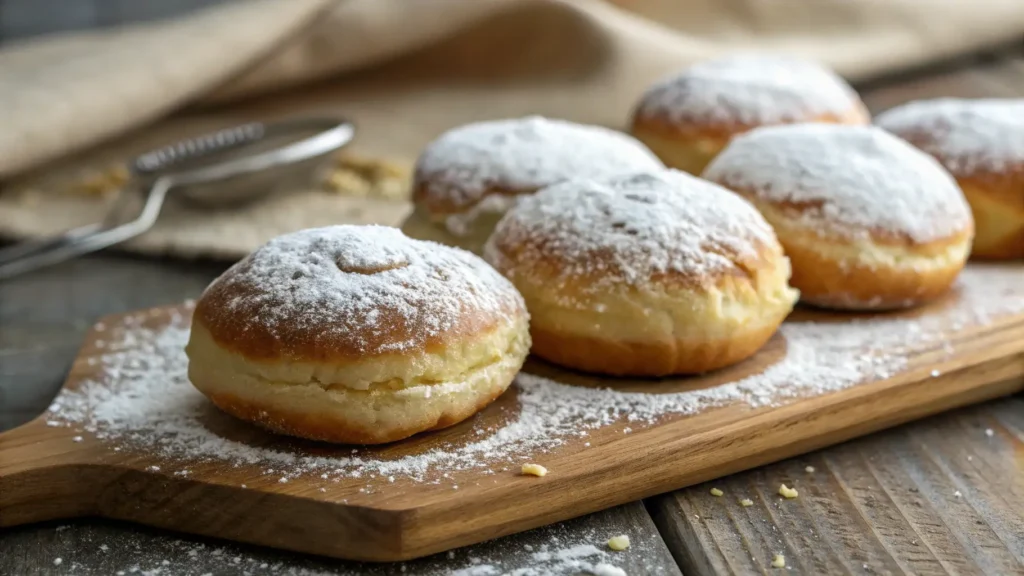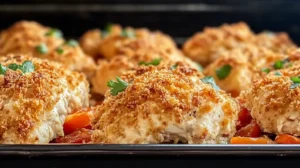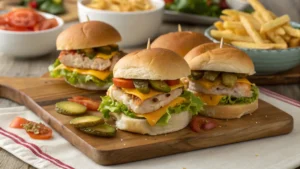Swiss Gipfeli is a delicious, flaky pastry that resembles a French croissant but has a unique texture and taste. Whether you’re craving a traditional Swiss breakfast or looking to impress guests with homemade pastries, this guide will walk you through the best Gipfeli recipe, complete with step-by-step instructions.
We’ll also cover the differences between a Gipfeli and a croissant, answer common questions, and provide expert tips to ensure your homemade pastries turn out perfectly.
Let’s get started!
Table of Contents
What Is a Gipfeli?
Understanding the Swiss Pastry
Gipfeli is a Swiss-style crescent roll that’s flakier than traditional croissants but contains less butter. It has a firmer texture, making it perfect for pairing with jam, butter, or even savory fillings.
Unlike traditional croissants, Gipfeli can be either sweet or savory, making them a versatile treat. Some versions include chocolate (Schokoladengipfeli) or almond filling (Mandelgipfel).
If you loved making these Gipfeli, why not try more delicious recipes? Start your day with these fluffy Banana Chocolate Chip Pancakes, or treat yourself to some irresistible Loaded Fries. Want perfectly crispy results every time? Check out this handy guide on getting the best texture in your air fryer. And for a sweet treat, don’t miss these chewy Blackberry Oatmeal Cookies. Happy cooking! ????️✨
How Gipfeli Differs From a Croissant
While both pastries share a similar crescent shape, there are key differences:
| Feature | Croissant | Gipfeli |
|---|---|---|
| Texture | Buttery, flaky | Flaky, firmer |
| Butter Content | High | Lower |
| Taste | Buttery, mild sweetness | Lightly sweet, sometimes savory |
| Layers | Multiple thin layers | Fewer layers, denser |
Gipfeli offers a less greasy texture, making it easier to handle and store compared to a croissant.
Ingredients for the Perfect Gipfeli Recipe
Before we dive into the baking process, let’s go over the essential ingredients you’ll need to make authentic Swiss Gipfeli at home.
Basic Dough Ingredients
To make light, flaky Gipfeli, gather these simple ingredients:
- 500g (4 cups) all-purpose flour – The base of the dough. You can also use bread flour for a slightly chewier texture.
- 10g (2 tsp) salt – Enhances the flavor and strengthens the dough structure.
- 50g (1/4 cup) sugar – Adds a mild sweetness to balance the flavor.
- 1 packet (7g) dry yeast – Helps the dough rise and creates a light, airy texture.
- 250ml (1 cup) warm milk – Activates the yeast and keeps the dough soft.
- 50g (1/4 cup) unsalted butter, softened – Adds richness and tenderness.
Optional Fillings & Toppings
While traditional Gipfeli is plain or lightly sweetened, you can experiment with different flavors:
- Chocolate – For a Schokoladengipfeli (chocolate-filled version).
- Ground almonds & sugar – To make Mandelgipfel, a nutty, sweet variation.
- Cheese & ham – A savory twist, great for breakfast.
- Egg wash – To give the Gipfeli a glossy, golden finish.
Why These Ingredients Matter
Each ingredient plays a key role in achieving the perfect texture and flavor. Yeast and warm milk create a soft, fluffy dough, while butter adds just enough richness without making the pastry too greasy.
Step-by-Step Guide to Making Gipfeli
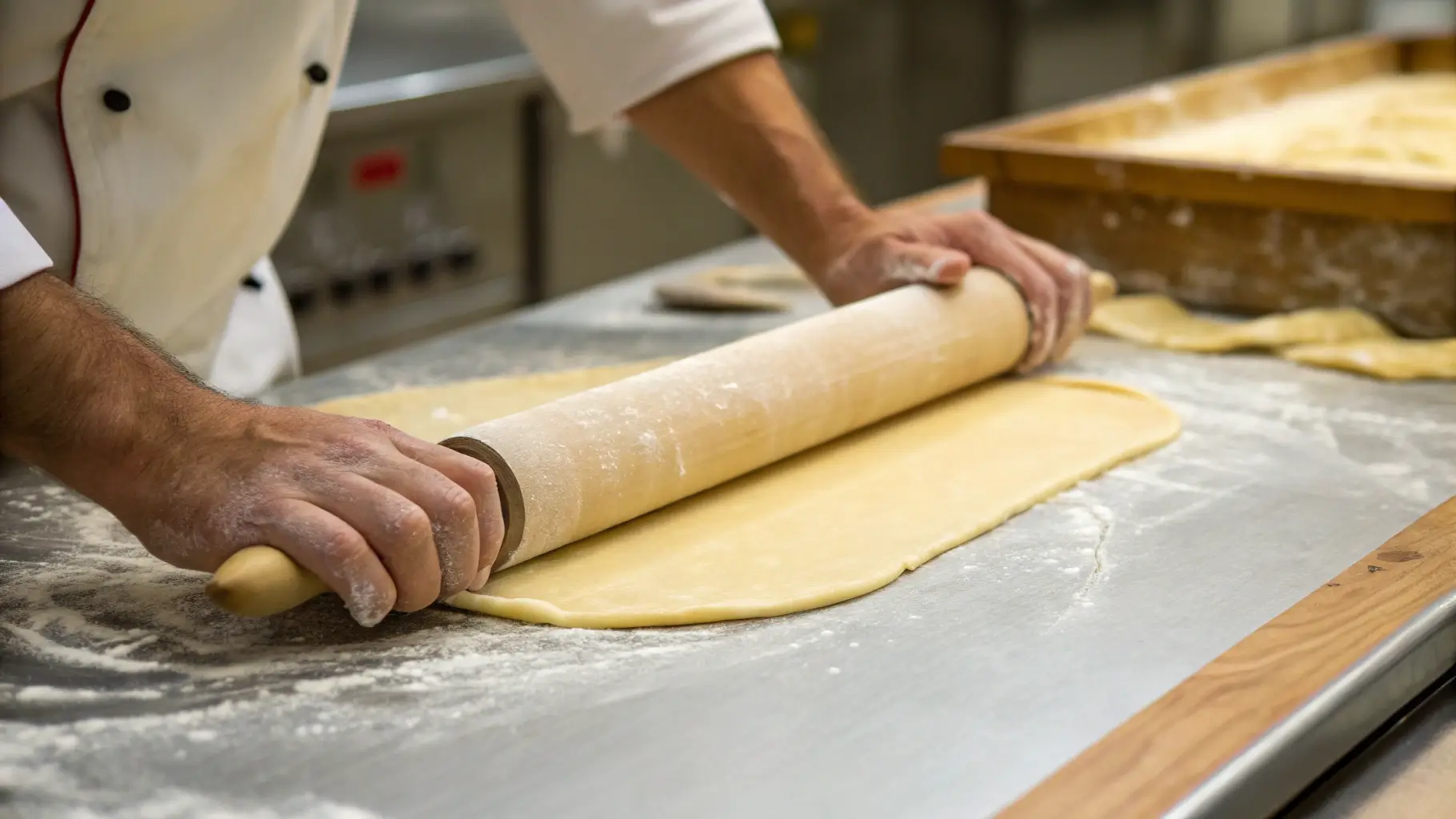
Now that we have all the ingredients ready, let’s go step by step to create the perfect Swiss Gipfeli at home.
1: Preparing the Dough
- Mix Dry Ingredients: In a large bowl, combine flour, salt, and sugar.
- Activate the Yeast: In a separate small bowl, dissolve the yeast in warm milk and let it sit for 5 minutes until foamy.
- Combine and Knead: Add the yeast mixture and softened butter to the dry ingredients. Mix until a dough forms, then knead for about 10 minutes until the dough is smooth and elastic.
- First Rise: Cover the dough with a clean towel and let it rest in a warm place for 1-2 hours, or until it doubles in size.
Pro Tip: The ideal temperature for proofing dough is 75–80°F (24–27°C). If your kitchen is cold, place the bowl near a warm oven or cover it with a damp towel.
2: Rolling and Shaping the Dough
- Roll Out the Dough: Once the dough has risen, transfer it to a floured surface and roll it into a large rectangle, about ½ cm (¼ inch) thick.
- Cut Into Triangles: Use a sharp knife or a pizza cutter to cut the dough into long triangular pieces, about 10 cm (4 inches) wide at the base.
- Shape the Gipfeli: Take each triangle and gently roll it from the base to the tip, forming a classic crescent shape.
- Place on Baking Sheet: Arrange the rolled Gipfeli on a baking sheet lined with parchment paper, making sure to leave space between them.
3: Baking the Gipfeli
- Second Rise: Cover the shaped Gipfeli with a clean towel and let them rest for 30 minutes. This helps create a lighter, fluffier texture.
- Egg Wash: Brush each Gipfeli with a beaten egg yolk mixed with a tablespoon of milk to give them a golden-brown color.
- Bake: Preheat your oven to 375°F (190°C). Bake the Gipfeli for 15-18 minutes, or until they turn a beautiful golden brown.
- Cool and Serve: Let the Gipfeli cool for a few minutes before serving. Enjoy them warm with butter, jam, or your favorite filling!
Troubleshooting Your Gipfeli
| Problem | Cause | Solution |
|---|---|---|
| Gipfeli are too dense | Dough didn’t rise long enough | Let them proof in a warm place for the full 1-2 hours |
| Not flaky enough | Dough was overworked | Knead gently and don’t add too much flour |
| Too dry or hard | Baked too long or too hot | Check oven temperature and reduce baking time |
Expert Tips for the Best Gipfeli
Now that you know how to make Gipfeli from scratch, let’s explore some expert tips to make them even better. Whether you want extra flakiness, a richer flavor, or the perfect golden crust, these tricks will help you achieve bakery-quality results.
1. Use the Right Flour for the Best Texture
While all-purpose flour works well, using bread flour can give your Gipfeli a slightly chewier and more structured texture. Bread flour has more protein, which helps create a better rise.
Pro Tip: If you want a softer, more delicate texture, use pastry flour instead.
2. Don’t Skip the Second Rise
Allowing the shaped Gipfeli to rest for 30 minutes before baking helps develop a light and airy interior. Skipping this step can result in dense, heavy pastries.
- If your kitchen is cold, place the baking sheet near a warm oven to speed up the process.
- A good indicator that they’re ready to bake is when they feel puffy and slightly jiggly when touched.
3. How to Get a Golden, Shiny Crust
The secret to a perfect golden brown Gipfeli is an egg wash.
- Classic egg wash: 1 egg yolk + 1 tablespoon of milk
- Extra shine: Add a teaspoon of honey or sugar to the egg wash
- For a crispier crust: Use only egg white instead of egg yolk
Brush the egg wash evenly right before baking for the best color.
4. Experiment with Fillings & Toppings
While plain Gipfeli is delicious, you can get creative with different flavors:
Sweet Variations:
- Schokoladengipfeli: Add small pieces of dark chocolate inside before rolling.
- Mandelgipfel: Fill with almond paste and sprinkle with sliced almonds.
- Vanilla Sugar Dusting: Sprinkle with powdered vanilla sugar after baking.
Savory Variations:
- Cheese & Ham: Add Swiss cheese and smoked ham for a hearty breakfast version.
- Pesto & Parmesan: Spread a thin layer of pesto before rolling and top with grated Parmesan.
- Garlic Butter: Brush baked Gipfeli with garlic-infused butter for a savory twist.
5. Store & Reheat Gipfeli the Right Way
Gipfeli taste best when fresh, but you can store them for later:
| Storage Method | How Long? | How to Reheat? |
|---|---|---|
| Room temperature | 1-2 days | Bake at 300°F (150°C) for 5 minutes |
| Refrigerator | Up to 5 days | Toast lightly or warm in an oven |
| Freezer | Up to 3 months | Bake frozen at 350°F (175°C) for 8-10 minutes |
Pro Tip: If you want extra crispiness, place a small cup of water in the oven while reheating. This adds moisture and prevents drying out.
6. Make-Ahead Gipfeli for Busy Mornings
Want fresh-baked Gipfeli without waking up early? Here’s how:
- Prepare the dough the night before and let it rise in the fridge overnight.
- Shape the Gipfeli and freeze them before baking. In the morning, bake directly from frozen (add 5 minutes to the baking time).
- Parbake method: Bake them for 10 minutes, then store them. When ready to eat, bake for another 5-7 minutes for a fresh taste.
Popular Variations of Gipfeli

Gipfeli comes in many delicious variations, both sweet and savory. While the classic Swiss Gipfeli is a breakfast staple, you can get creative by adding different fillings and toppings. Below are some of the most popular Gipfeli variations you can try at home.
1. Mandelgipfel (Almond Gipfeli)
Mandelgipfel is a sweet almond-filled version of Gipfeli, perfect for those who love nutty flavors.
How to Make Mandelgipfel:
- Add a layer of almond paste or marzipan before rolling the dough.
- Brush with egg wash and sprinkle with sliced almonds.
- Bake as usual and dust with powdered sugar before serving.
Pro Tip: For extra almond flavor, mix a few drops of almond extract into the dough.
2. Schokoladengipfeli (Chocolate-Filled Gipfeli)
If you love pain au chocolat, you’ll love this Swiss chocolate-filled Gipfeli.
How to Make Schokoladengipfeli:
- Place a few small chocolate pieces (dark, milk, or white) inside each dough triangle before rolling.
- After baking, drizzle with melted chocolate for extra indulgence.
Best Chocolate to Use:
- Dark chocolate (70% cocoa) for a rich, less sweet flavor
- Milk chocolate for a classic Swiss-style treat
- Nutella for a creamy chocolate-hazelnut filling
3. Buttergipfeli (Classic Butter Gipfeli)
This is the most traditional Swiss Gipfeli, often enjoyed with butter, jam, or honey.
How to Make Buttergipfeli:
- Use high-quality unsalted butter for the best flavor.
- Brush the dough with a little melted butter before rolling for extra richness.
- Serve warm with fruit jam, honey, or Nutella.
4. Savory Ham & Cheese Gipfeli
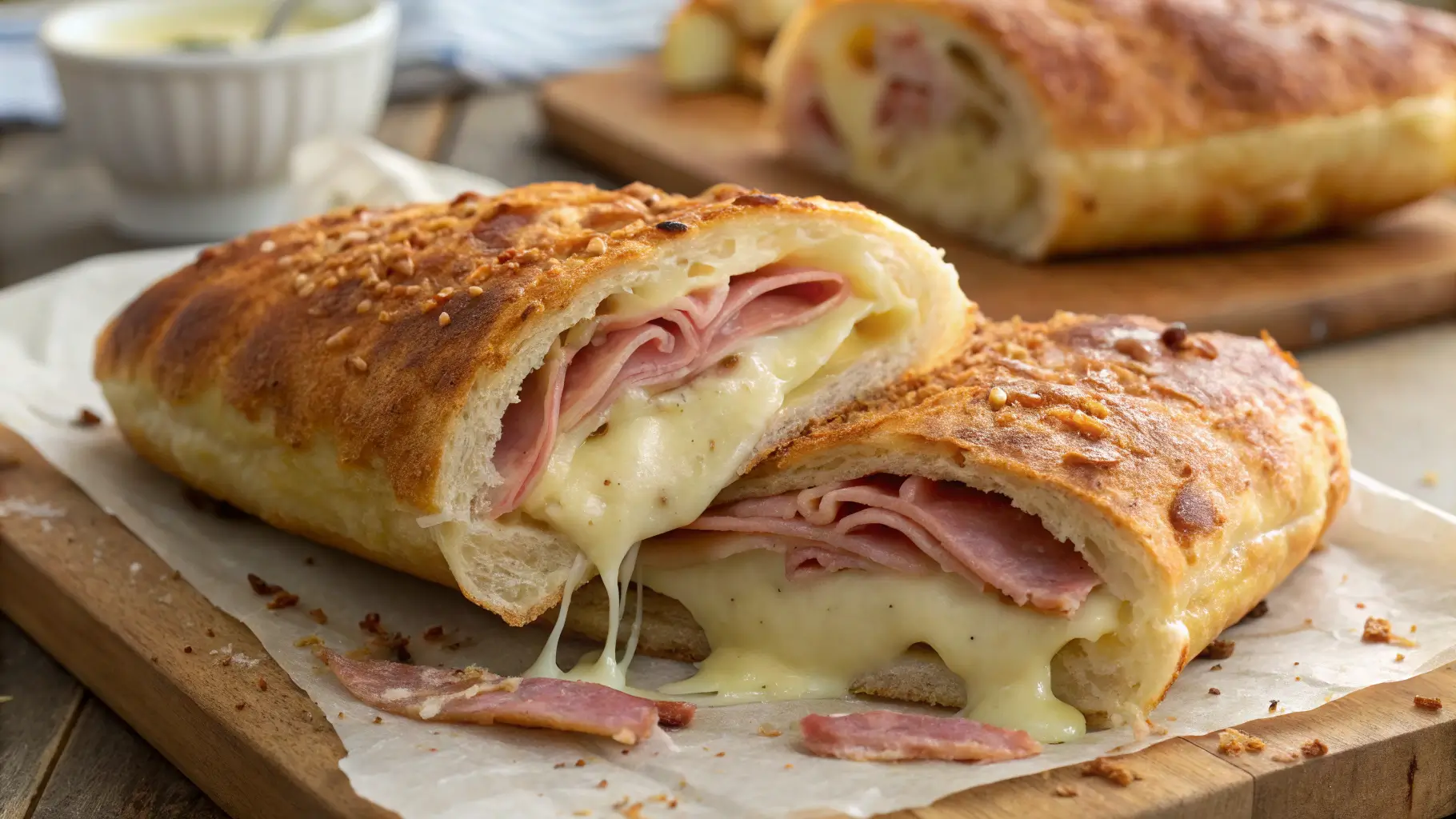
For a hearty breakfast or snack, try a savory version of Gipfeli with Swiss cheese and smoked ham.
How to Make Ham & Cheese Gipfeli:
- Add a thin slice of Gruyère, Emmental, or cheddar cheese and a slice of ham before rolling.
- Brush with egg wash and sprinkle with sesame or poppy seeds.
- Serve warm with mustard or butter.
Pro Tip: Try adding caramelized onions or a little Dijon mustard for extra flavor.
5. Pesto & Parmesan Gipfeli
This Mediterranean-inspired Gipfeli is packed with flavor and makes a great appetizer.
How to Make Pesto & Parmesan Gipfeli:
- Spread a thin layer of pesto on the dough before rolling.
- Sprinkle the top with grated Parmesan cheese.
- Bake until golden and enjoy as a savory snack.
6. Vegan Gipfeli (Dairy-Free Version)
If you want a plant-based version, it’s easy to make Gipfeli without dairy.
How to Make Vegan Gipfeli:
- Use plant-based milk (almond, soy, or oat) instead of dairy milk.
- Replace butter with vegan margarine or coconut oil.
- Brush with a mix of plant-based milk and maple syrup instead of egg wash.
Pro Tip: Add a teaspoon of ground flaxseeds to the dough for extra softness.
7. Garlic Butter & Herb Gipfeli
A perfect side for soups or salads, this savory garlic herb version is full of flavor.
How to Make Garlic Butter Gipfeli:
- Add minced garlic and fresh herbs (parsley, rosemary, or thyme) to melted butter.
- Brush the Gipfeli with garlic butter before and after baking.
- Sprinkle with coarse sea salt for extra taste.
Best Served With:
- Tomato soup
- Cheese fondue
- Roasted vegetables
Which Gipfeli Variation Will You Try?
Now that you know the most popular variations of Gipfeli, it’s time to get baking! Whether you prefer sweet, savory, or classic butter Gipfeli, these recipes will bring a taste of Swiss tradition to your kitchen.
FAQs About Gipfeli
Many people have questions about Gipfeli, especially how they compare to croissants and how to perfect them at home. Below are answers to the most commonly asked questions to help you master the art of making Swiss Gipfeli.
What is the difference between a croissant and a Gipfeli?
The main difference between a croissant and a Gipfeli lies in their butter content and texture. Croissants are buttery, soft, and extremely flaky, with multiple thin, airy layers that create a delicate, melt-in-your-mouth experience. They have a high butter content, giving them a rich, mildly sweet flavor. In contrast, Gipfeli have fewer layers and a slightly firmer, denser texture, making them less greasy while still maintaining a flaky bite. They contain less butter and can be enjoyed in both sweet and savory variations, offering a more structured and versatile pastry compared to the traditional French croissant.
What is the Swiss version of a croissant?
The Gipfeli is the Swiss counterpart to the French croissant. Unlike croissants, Gipfeli has less butter, a firmer texture, and can be made in both sweet and savory varieties.
What is a Mandelgipfel?
A Mandelgipfel is a variation of Gipfeli that is filled with almond paste and topped with sliced almonds and powdered sugar. It has a deliciously nutty and sweet flavor.
What is the secret to a good croissant (or Gipfeli)?
The key to a perfect flaky, airy Gipfeli lies in:
Proper yeast activation – Ensures the dough rises well.
Letting the dough rest twice – This helps develop the perfect texture.
Using an egg wash – Creates a golden-brown crust.
Baking at the right temperature – Ensures even cooking without burning.
What is a cross between a doughnut and a croissant called?
A cronut is a hybrid of a croissant and a doughnut, invented by French pastry chef Dominique Ansel. It has the flaky layers of a croissant but is deep-fried like a doughnut.
What is the 7 Days croissant called?
The 7 Days Croissant is a popular packaged filled croissant-style pastry made by the company 7 Days. It’s not the same as a traditional handmade croissant or Gipfeli because it has a softer, more cake-like texture.
What do Italians call croissants?
In Italy, croissants are called “Cornetto” (plural: Cornetti). Unlike French croissants, Cornetti are slightly sweeter and may contain vanilla or citrus flavors.
What is the Scottish version of a croissant?
The Scottish version of a croissant is the “Butteries” or “Rowies”. These are flaky, buttery pastries, but they are denser and saltier than croissants or Gipfeli.
Final thoughts
You’ve now learned everything you need to know about making authentic Swiss Gipfeli—from its history and variations to expert tips and FAQs. Whether you prefer a classic Buttergipfeli, a sweet Mandelgipfel, or a savory ham and cheese version, you can now create these delicious pastries right at home.
Final Tips for Perfect Gipfeli
✔ Use fresh yeast for the best rise and texture.
✔ Let the dough rest twice to create a light, flaky pastry.
✔ Experiment with fillings like chocolate, almonds, or cheese.
✔ Brush with egg wash for a beautiful golden color.
✔ Bake at the right temperature to ensure a crispy exterior and soft interior.
Gipfeli is more than just a breakfast pastry—it’s a taste of Swiss tradition. With this guide, you can bring a little bit of Switzerland into your kitchen and enjoy freshly baked Gipfeli whenever you like!
